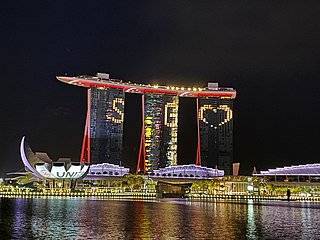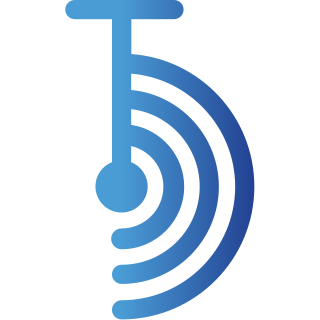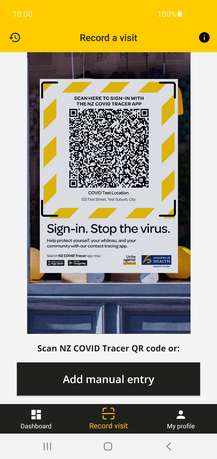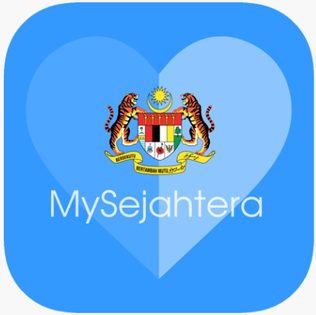
A QR code is a type of two-dimensional matrix barcode, invented in 1994, by Japanese company Denso Wave for labelling automobile parts. A barcode is a machine-readable optical image that contains information specific to the labelled item. In practice, QR codes contain data for a locator, an identifier, and a website visitor tracking. To efficiently store data, QR codes use four standardized modes of encoding (i) numeric, (ii) alphanumeric, (iii) byte or binary, and (iv) kanji.
Mobile ticketing is the process whereby customers order, pay for, obtain, and validate tickets using mobile phones. A mobile ticket contains a verification unique to the holder's phone. Mobile tickets reduce the production and distribution costs associated with paper-based ticketing for operators by transferring the burden to the customer, who is required to contribute the cost of the physical device (smartphone) and internet access to the process. As a result of these prerequisites, and in contrast to paper-based systems, mobile ticketing does not follow the principles of universal design.
Asset tracking refers to the method of tracking physical assets, either by scanning barcode labels attached to the assets or by using tags using GPS, BLE, LoRa, or RFID which broadcast their location. These technologies can also be used for indoor tracking of persons wearing a tag.
QR code payment is a contactless payment method where payment is performed by scanning a QR code from a mobile app. This is an alternative to doing electronic funds transfer at point of sale using a payment terminal. This avoids a lot of the infrastructure traditionally associated with electronic payments such as payment cards, payment networks, payment terminal and merchant accounts.

The COVID-19 pandemic in Singapore was a part of the worldwide pandemic of coronavirus disease 2019 caused by severe acute respiratory syndrome coronavirus 2. The first case in Singapore was confirmed on 23 January 2020. Early cases were primarily imported until local transmission began to develop in February and March. In late March and April, COVID-19 clusters were detected at multiple migrant worker dormitories, which soon contributed to an overwhelming proportion of new cases in the country.

COVID-19 apps include mobile-software applications for digital contact-tracing - i.e. the process of identifying persons ("contacts") who may have been in contact with an infected individual - deployed during the COVID-19 pandemic.

BlueTrace is an open-source application protocol that facilitates digital contact tracing of users to stem the spread of the COVID-19 pandemic. Initially developed by the Singaporean Government, BlueTrace powers the contact tracing for the TraceTogether app. Australia and the United Arab Emirates have already adopted the protocol in their gov apps, and other countries were considering BlueTrace for adoption. A principle of the protocol is the preservation of privacy and health authority co-operation.
TraceTogether is a digital system implemented by the Government of Singapore to facilitate contact tracing efforts in response to the COVID-19 pandemic in Singapore. The main goal is quick identification of persons who may have come into close contact with anyone who has tested positive for COVID-19. The system helps in identifying contacts such as strangers encountered in public one would not otherwise be able to identify or remember. Together with SafeEntry, it allows the identification of specific locations where a spread between close contacts may occur.

Digital contact tracing is a method of contact tracing relying on tracking systems, most often based on mobile devices, to determine contact between an infected patient and a user. It came to public prominence in the form of COVID-19 apps during the COVID-19 pandemic. Since the initial outbreak, many groups have developed nonstandard protocols designed to allow for wide-scale digital contact tracing, most notably BlueTrace and Exposure Notification.
The following is a timeline of the COVID-19 pandemic in Singapore in 2020.

The 2020–21 Singapore circuit breaker measures were a stay-at-home order and cordon sanitaire implemented as a preventive measure by the Government of Singapore in response to the COVID-19 pandemic in the country on 7 April 2020.

NZ COVID Tracer is a mobile software application that enables a person to record places they have visited, in order to facilitate tracing who may have been in contact with a person infected with the COVID-19 virus. The app allows users to scan official QR codes at the premises of businesses and other organisations they visit, to create a digital diary. It was launched by New Zealand's Ministry of Health on 20 May 2020, during the ongoing COVID-19 pandemic. It can be downloaded from the App Store and Google Play.
careFIJI is a mobile software application developed by the Government of Fiji to assist the Ministry of Health and Medical Services in combating the ongoing COVID-19 pandemic in Fiji. The mobile app is available on Google Play and the App Store.
LeaveHomeSafe is a digital contact tracing app launched by the Hong Kong Government on 16 November 2020 to conduct contact tracing in Hong Kong. It can be used as a companion of the Hong Kong Health Code system for registered users.

MySejahtera is a mobile application developed by Entomo Malaysia and the Government of Malaysia to manage the COVID-19 outbreak in Malaysia. It can be used to conduct contact tracing, self-quarantine, and also book COVID-19 vaccination appointments.

A COVID-19 vaccine card is a record often given to those who have received a COVID-19 vaccine showing information such as the date(s) one has received the shot(s) and the brand of vaccine one has received, sometimes including the lot number. The card also contains information identifying the recipient and the location where the shot was given. Depending on the country, it could serve as an official document verifying one has received vaccination, which could be required by some institutions, such as a school or workplace, when boarding a cruise ship, or when crossing an international border, as proof that one has been vaccinated.
The following is a timeline of the COVID-19 pandemic in Singapore in 2021.
The NZ Pass Verifier is a free mobile app developed by the New Zealand Ministry of Health for businesses and organisations to scan and verify their customers' My Vaccine Pass certificates. The app was launched on 23 November 2021 for use on smartphones.
The following is a timeline of the COVID-19 pandemic in Singapore in 2022.
The following is a timeline of the COVID-19 pandemic in Singapore in 2023.









